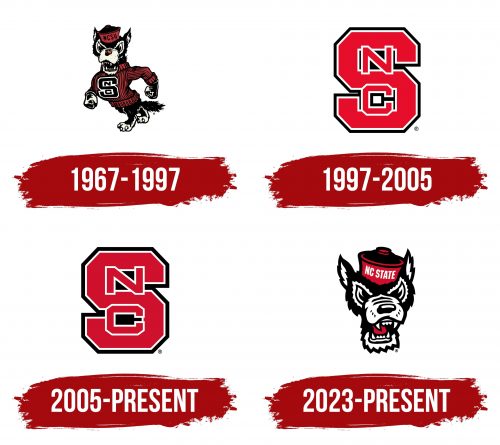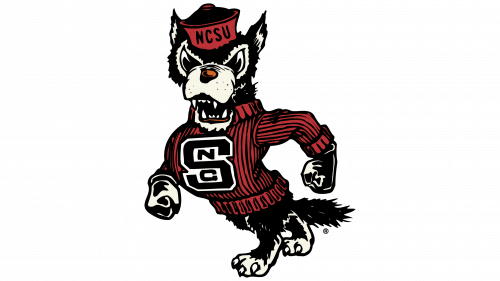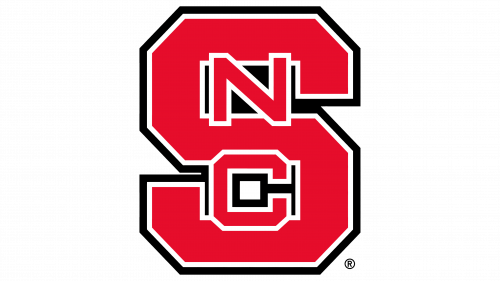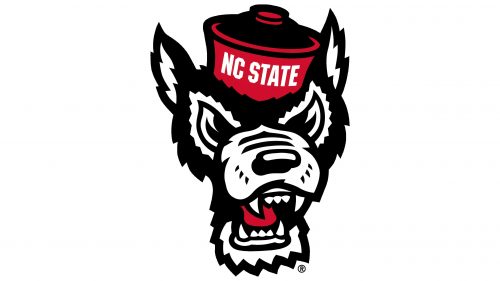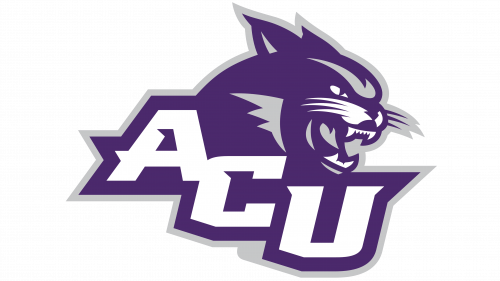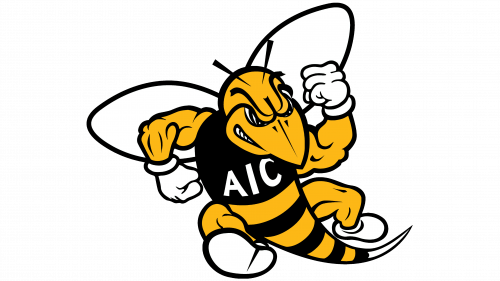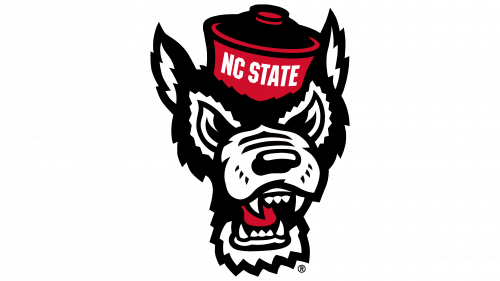 North Carolina State Wolfpack Logo PNG
North Carolina State Wolfpack Logo PNG
The North Carolina State Wolfpack logo conveys the team’s character, with its fierce name perfectly complemented by a visual mascot. The emblem effectively captures the fierce determination of athletes driven to win and ready to “tear apart” their opponents during competitions.
North Carolina State Wolfpack: Brand overview
The establishment of North Carolina State University in 1887 marks the beginning of the North Carolina State Wolfpack’s history. The university was founded to provide agricultural and mechanical education to students and was formerly known as the North Carolina College of Agriculture and Mechanic Arts.
Sports teams at the university started to form not long after it was established. The football squad, which would later form the foundation of the Wolfpack, took on the University of North Carolina at Chapel Hill in its inaugural match in 1892.
Much later, in 1921, the moniker “Wolfpack” emerged. Due to the university’s emphasis on agriculture, the teams were called “Aggies” or “Farmers” before that. The football team’s actions were compared to those of a “wolfpack” in the first-ever student newspaper piece that featured the phrase “Wolfpack.” After gaining rapid traction, the university’s sports teams adopted the nickname as their official moniker.
The athletic programs expanded and developed during the 1920s and 1930s. After Riddick Stadium was constructed in 1924, it was the football team’s home for many years.
Under coach Everett Case, the basketball program experienced significant success in the 1940s. After the squad won the Southern Conference in 1947 and 1948, the university started a storied basketball program.
A new era in athletics programs began in 1953 when the university became one of the seven original Atlantic Coast Conference (ACC) members.
The best years for the basketball program were the 1960s and 1970s. In 1974, under head coach Norm Sloan, the squad defeated Marquette in the final to win their first NCAA national championship.
The football program also saw notable success during this time. Under head coach Earle Edwards, the squad earned its first ACC championship in 1957 and went on to win more titles in 1963, 1964, 1965, and 1968.
1983 stands out as a particularly remarkable year for sports teams. The basketball team, captained by the illustrious Jim Valvano, defeated Houston in one of the most thrilling games in the tournament’s history to win its second NCAA national championship.
The athletic departments underwent more development in the 1990s and 2000s. Under head coach Chuck Amato, the football team was a consistent bowl participant and enjoyed success.
Women’s sports programs also attained significant success. Under the direction of coach Kay Yow, the women’s basketball team rose to prominence and began to compete in the NCAA tournament regularly.
Carter-Finley Stadium, constructed in 2000, is the football team’s new home. It replaces the dilapidated Riddick Stadium.
Under head coach Chuck Amato, the football program saw some success from 2000 to 2006. The squad played in bowl games regularly and defeated Notre Dame in the 2003 Gator Bowl. However, after 2006, the program ran into difficulties.
Tom O’Brien was named the football team’s head coach in 2007. Under his direction, the team experienced some success, including a 2011 Belk Bowl victory.
2013 was the first year of Dave Doeren’s tenure as the football team’s head coach. Under his direction, the squad performed admirably and frequently made it to bowl games.
The early 2000s were difficult for basketball. Following the departure of legendary coach Jim Valvano, the program underwent reconstruction.
Sidney Lowe was named head coach of the men’s basketball team in 2006. However, he was not very successful.
When Mark Gottfried was named head coach in 2011, the basketball program underwent a sea change. Under his direction, the squad qualified for four straight NCAA tournaments, including two trips to the Sweet Sixteen in 2012 and 2015.
The men’s basketball team entered a new chapter in 2017 when Kevin Keatts was named head coach.
Legendary coach Kay Yow led the women’s basketball program to continual success until her retirement in 2009. Following her departure, the program went through a rebuilding phase.
The university was also quite successful in other sports. The baseball club reached this stage in 2013 and 2021 and regularly competed in the College World Series.
After taking home multiple individual national titles, the wrestling program developed into one of the best in the nation.
Two NCAA national titles won by the women’s cross-country team in 2021 and 2022 represented a noteworthy accomplishment for the college.
The university continued enhancing its sports facilities. Reynolds Coliseum, the home arena of numerous teams, underwent extensive renovations that were finished in 2016.
The institution also weighed the academic performance of the athletes. The school was frequently honored for its outstanding academic standing and high graduation rates among its student-athletes.
Many of the exceptional players the university has developed have gone on to have great careers in professional sports. These include football players Torry Holt and Philip Rivers, baseball player Trent Thornton, basketball players David Thompson and Tom Gugliotta, and numerous others.
The university’s athletic accomplishments and rich traditions have brought students, alumni, and supporters together and have significantly shaped its identity.
Meaning and History
What is the North Carolina State Wolfpack?
These are the sports teams of NC State University, competing in the Atlantic Coast Conference. Their home stadium, Carter-Finley, fills with passionate fans on game days, creating an incredible atmosphere as the stands turn into a sea of red. The athletic department has a long history of success in sports like football, basketball, and wrestling. The university attracts student-athletes who achieve high academic and sports results thanks to a harmonious blend of academic rigor and athletic skill.
1967 – 1997
The North Carolina State Wolfpack emblem resonates with its name. Designers worked to bring this name to life as accurately as possible, aligning the visual image with the character of the real animal. They incorporated its most fitting traits, those that echo the sports arena.
The result is a logo with a cartoon-like depiction of a wolf. From the wild animal, it retains only the fangs and claws, while other features are anthropomorphized. Thus, it has:
- massive fists;
- a fierce gaze;
- alert ears;
- a muscular chest;
- a confident stride.
The wolf also sports a raised fur mane and a long tail. On its head is a round cap resembling a skullcap, with “NC State” written in white letters on a red background, marking the location of the sports department—North Carolina. This detail underscores the teams’ authenticity.
Due to its unique look, this logo is called Tuffy the Strutting Wolf. The wolf’s large eyes gleam with hostility, affirming its reputation as a predator, and sharp teeth protrude from its open mouth. The animal walks confidently to the left, turning its head toward viewers. It wears a red sweater with the abbreviation “NCS,” which appears monogrammed, with the letters layered over each other.
The illustration uses three colors: black, white, and red, which are part of the university’s official palette. These colors contrast well, helping highlight the emblem’s most important elements.
1997 – 2005
Only one element remains from the previous North Carolina State Wolfpack logo—the block “S.” It has a standard look, as letters in this style are commonly seen in most sports team logos. The massive glyph has no rounded corners; all edges are cut diagonally, replacing traditional curves with sharp turns. As a result, the wide lines appear rough and clumsy.
Two borders along its entire perimeter outline the single letter: the outer frame is black, and the inner one is white. The contrast between them creates a strict atmosphere, emphasizing the serious nature of the athletes. The glyph itself is dark maroon. Two additional letters are placed on its background:
- “N” (in the upper open area)
- “C” (in the lower curve).
The central symbols are smaller and thinner than the “S,” but they also feature a geometric design with sharp-cornered cuts instead of curves. This mark transitioned from the cartoon wolf’s sweater and replicates the original version. This design choice was intended to highlight the connection between the visual identity and the team’s name, showcasing authenticity using the “NCS” abbreviation, representing North Carolina State.
2005 – today
This year’s changes did not affect the shape or structure of the North Carolina State Wolfpack logo. It still appears as a single block-style mark without serifs. The wide strokes give it a modern feel and reflect the athletes’ confidence. Such a powerful emblem conveys a sense of reliability, resilience, and professionalism.
The primary change lies in the palette: dark maroon has been replaced with a rich red, aligning better with the university’s official colors. This red replaces any dynamic elements absent in the emblem. It infuses the logo with energy and adds emotional intensity, emphasizing peak moments on the stadium field and in the stands.
But the color change isn’t the only update. Designers also refined the “N” and “C.” Specifically, they worked meticulously on the glyphs:
- increased their boldness;
- made them wider;
- enlarged them.
Interestingly, all this was achieved with one action: the letters were compressed from top to bottom. This is most evident in the inner spaces of the “S”: glyphs that were once small now cover them. The black-and-white border and dark background remain as they underscore the athletes’ seriousness. These colors also balance well with red, tempering its intensity.
2023 – today
The university administration decided to bring back the wolf for their teams, as fans loved it. It accurately represented the athletes and highlighted their uniqueness, closely connected to the region. However, the designers aimed to avoid anthropomorphism and showcase more individual characteristics of the character. They used only the animal’s head from the 1967–1997 logo.
The wolf looks just as before, but in a mirror image—flipped from left to right. In other words, it’s facing the opposite direction. The animal has a fierce expression and a wide-open mouth, exposing sharp, intimidating fangs. Its ears are raised attentively as though it’s listening carefully, striving to keep everything under control.
The wolf wears a round cap without a brim, resembling a skullcap. On its front, the first part of the sports division and the university’s name, “NC State,” are written in white letters, indicating their connection and the teams’ location—North Carolina.
The text is in a geometric font: even, bold, and uppercase, with letters placed close together. Despite the narrow spacing, the inscription is easily readable due to the wolf’s enlarged head.
The emblem is colored in three shades, two of which are the university’s official colors: red and white. Black serves as a contrasting color, harmonizing with the other two. As a result, the mascot appears bold and defined.
